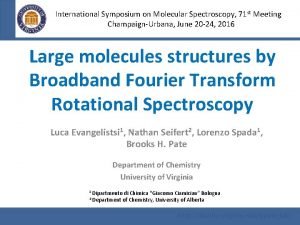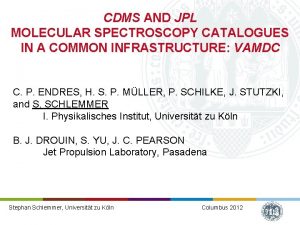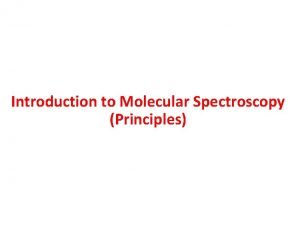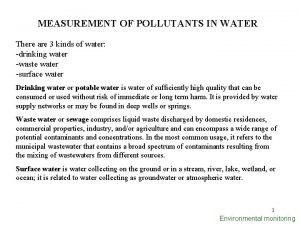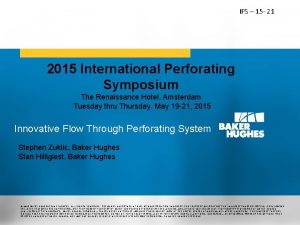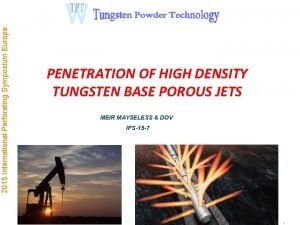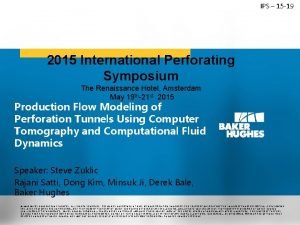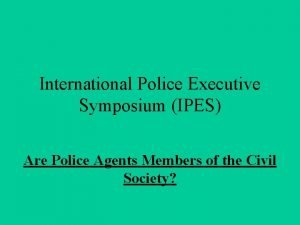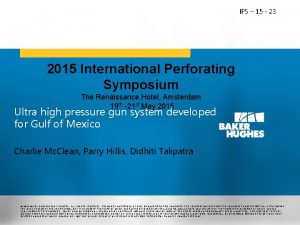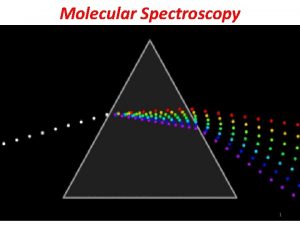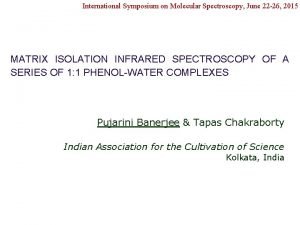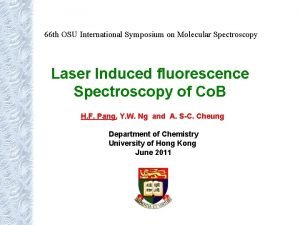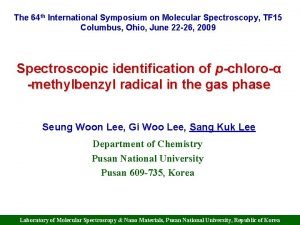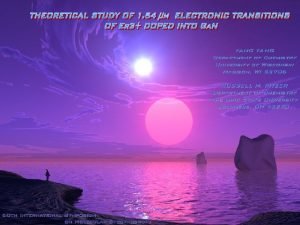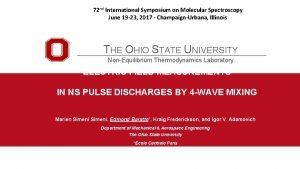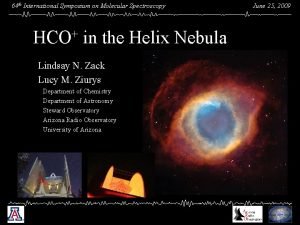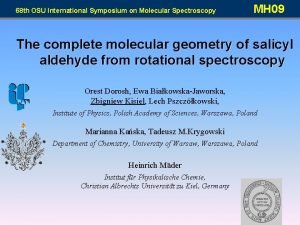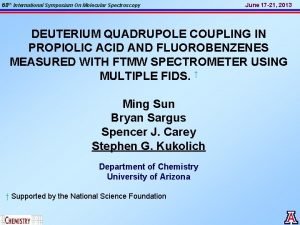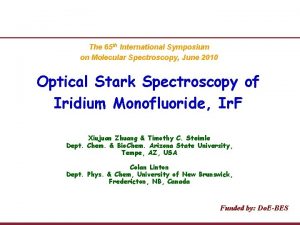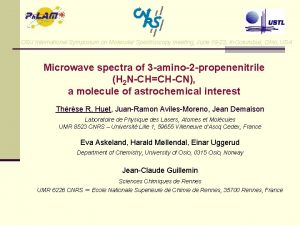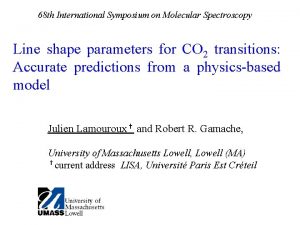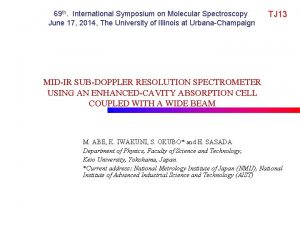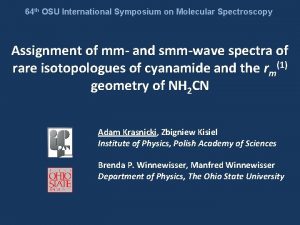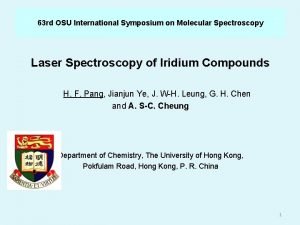The 68 th International Symposium on Molecular Spectroscopy




![Observation (6, 0)[16. 0]1. 5 -X 2 D 5/2 band Complicated spectrum Large isotopic Observation (6, 0)[16. 0]1. 5 -X 2 D 5/2 band Complicated spectrum Large isotopic](https://slidetodoc.com/presentation_image/7da073667087f425523f64e42031d91b/image-5.jpg)
![Observation (cont. ) (6, 0)[16. 0]1. 5 -X 2 D 5/2 band Resolution ~30 Observation (cont. ) (6, 0)[16. 0]1. 5 -X 2 D 5/2 band Resolution ~30](https://slidetodoc.com/presentation_image/7da073667087f425523f64e42031d91b/image-6.jpg)
![Modeling the (6, 0)[16. 0]1. 5 -X 2 5/2 band system 1. Effective Hamiltonian Modeling the (6, 0)[16. 0]1. 5 -X 2 5/2 band system 1. Effective Hamiltonian](https://slidetodoc.com/presentation_image/7da073667087f425523f64e42031d91b/image-7.jpg)





![Predicted spectra LIF signal m(X 2 5/2)=+0. 414(6)D m([16. 0]1. 5(v=6))=-0. 782(6)D m(X 2 Predicted spectra LIF signal m(X 2 5/2)=+0. 414(6)D m([16. 0]1. 5(v=6))=-0. 782(6)D m(X 2](https://slidetodoc.com/presentation_image/7da073667087f425523f64e42031d91b/image-13.jpg)


![Summary ØRecorded high resolution LIF of the (6, 0)[16. 0]1. 5 - X 2 Summary ØRecorded high resolution LIF of the (6, 0)[16. 0]1. 5 - X 2](https://slidetodoc.com/presentation_image/7da073667087f425523f64e42031d91b/image-16.jpg)



- Slides: 19

The 68 th International Symposium on Molecular Spectroscopy, June 2013 The electric dipole moment of Iridium monosilicide, Ir. Si Anh T. Le and Timothy C. Steimle Department of Chemistry and Biochemistry, Arizona State University, Tempe, AZ 85287 Michael D. Morse and Maria A. Garcia Department of Chemistry, University of Utah, Salt Lake City, UT 84112, USA Lan Cheng and John F. Stanton Funded by Do. E -BES The University of Texas at Austin, TX 78712 -0165.

Motivation Ø Iridium containing molecules • Ir. Si?

Previous work • Prof Morse’s group: Recorded 31 electronic bands * ØRecorded high resolution LIF of the (6, 0)[16. 0]1. 5 - X 2 5/2 bands for 191&193 Ir. Si (lowest angular momentum quantum number) ØAnalyzed, determined the fine and hyperfine parameters ØRecorded & Analyzed Stark spectra to determine the molecular dipole moments for the X 2 5/2 and [16. 0]1. 5(v=6) states

Experiment method Ablation laser Gated photon counter Skimmer Stark Plates Well collimated molecular beam Rot. Temp. <20 K Electric field ~ 4000 V/cm Resolution ~30 MHz CW dye laser
![Observation 6 016 01 5 X 2 D 52 band Complicated spectrum Large isotopic Observation (6, 0)[16. 0]1. 5 -X 2 D 5/2 band Complicated spectrum Large isotopic](https://slidetodoc.com/presentation_image/7da073667087f425523f64e42031d91b/image-5.jpg)
Observation (6, 0)[16. 0]1. 5 -X 2 D 5/2 band Complicated spectrum Large isotopic shifts (1. 5 cm-1) between 191 Ir. Si, 193 Ir. Si Formed a head quickly due to large difference in rotational constants Highly overlapped Need to understand the field free spectrum to be able to study the Stark spectra
![Observation cont 6 016 01 5 X 2 D 52 band Resolution 30 Observation (cont. ) (6, 0)[16. 0]1. 5 -X 2 D 5/2 band Resolution ~30](https://slidetodoc.com/presentation_image/7da073667087f425523f64e42031d91b/image-6.jpg)
Observation (cont. ) (6, 0)[16. 0]1. 5 -X 2 D 5/2 band Resolution ~30 MHz
![Modeling the 6 016 01 5 X 2 52 band system 1 Effective Hamiltonian Modeling the (6, 0)[16. 0]1. 5 -X 2 5/2 band system 1. Effective Hamiltonian](https://slidetodoc.com/presentation_image/7da073667087f425523f64e42031d91b/image-7.jpg)
Modeling the (6, 0)[16. 0]1. 5 -X 2 5/2 band system 1. Effective Hamiltonian Heff = Hso+ Hrot + Hmhf(Ir)+ He. Qq(Ir) Ir(I=3/2) 2. 16 x 16 Matrix representation: Hund’s case (ab. J) coupled basis set: Eigenvalues & Eigenvectors Parameters: B, h 5/2(191, 193 Ir) and e. Qq 0(191, 193 Ir) for the X 2 5/2(v=0) state, T 00, B, h 3/2(191, 193 Ir) and e. Qq 0(191, 193 Ir) for the (6, 0)[16. 0]1. 5

Predicted spectra Stark effect (next slide) Ready for Stark measurement & analysis

P(5/2) under applied electric field 2339 V/cm|| LIF signal 1754 V/cm|| 1169 V/cm|| 0 V/cm 191 P(11/2)

Facing the Challenge • 9 field free transitions in P(5/2) splits into ~30 intense MJ= MF transitions, and numerous weaker MJ MF transitions under applied electric field • Fully resolved at voltage higher than 4000 V/cm (impossible)

What to expect? 1. Comparison with isovalent Ir. C m(X 2 5/2)=1. 60(7) D Expect small positive dipole moment 2. Electronegativity Si (8. 15 e. V)<Ir (9. 0 e. V) Possible to have small negative dipole moment

Stark spectra of Ir. Si Predicted spectra C, D AB 1754 V/cm|| c b a A B C D LIF signal a b c 193 Ir. Si, P(5/2)
![Predicted spectra LIF signal mX 2 520 4146D m16 01 5v60 7826D mX 2 Predicted spectra LIF signal m(X 2 5/2)=+0. 414(6)D m([16. 0]1. 5(v=6))=-0. 782(6)D m(X 2](https://slidetodoc.com/presentation_image/7da073667087f425523f64e42031d91b/image-13.jpg)
Predicted spectra LIF signal m(X 2 5/2)=+0. 414(6)D m([16. 0]1. 5(v=6))=-0. 782(6)D m(X 2 5/2)=-0. 414 (6)D m([16. 0]1. 5(v=6))=0. 782(6)D

Difference in bonding Ir. Si and Ir. C Si (8. 15 e. V) Ir. Si: Covalent bond Ir (9. 0 e. V) C (11. 25 e. V) Ir. C: Ionic bond

Compare with other Ir - containing molecule Predict the reduced dipole moment of other Ir-containing molecule • • Ir. P • Ir. S Ir. Cl • Ir. O
![Summary ØRecorded high resolution LIF of the 6 016 01 5 X 2 Summary ØRecorded high resolution LIF of the (6, 0)[16. 0]1. 5 - X 2](https://slidetodoc.com/presentation_image/7da073667087f425523f64e42031d91b/image-16.jpg)
Summary ØRecorded high resolution LIF of the (6, 0)[16. 0]1. 5 - X 2 5/2 bands for 191&193 Ir. Si ØAnalyzed, determined the fine and hyperfine parameters ØRecorded & Analyzed Stark spectra to determine the molecular dipole moments for the X 2 5/2 and [16. 0]1. 5(v=6) states ØHigh level relativistic calculations are in good agreement with observed dipole moment and e. Qq 0 (mag. hyperfine? ) ØCompared reduce dipole moment of other Ir-containing molecules with Ir. Si ØPredict the reduced dipole moment of other Ir-containing molecule

Thank you Advisor: Prof. Timothy C. Steimle Collaborations: ØProf. Michael Morse (University of Utah) –Ir. Si ØProf. John Stanton, Dr. Lan Cheng (U. Texas-Austin) -Ir. Si Group members: Ø Fang Wang Ø Ruohan Zhang Funding sources: Do. E-BES


Stark spectra of Ir. Si Determined Isovalent Ir. C dipole moments of Ir. Si m(X 2 5/2)=-0. 4139(64) D Comparison m(X 2 5/2)=1. 60(7) D m([16. 0]1. 5(v=6))=0. 7821(63) D X 2 5/2 : 1 2 1 4 2 2 1 3 3 2 X 2 5/2 : 1 2 1 4 2 2 1 33 2 Why? next slide
 International symposium on molecular spectroscopy
International symposium on molecular spectroscopy Upcdms
Upcdms Applications of uv spectroscopy
Applications of uv spectroscopy Difference between atomic and molecular spectroscopy
Difference between atomic and molecular spectroscopy Erzeng xue
Erzeng xue International perforating symposium
International perforating symposium International perforating symposium
International perforating symposium Ips perforating
Ips perforating International police executive symposium
International police executive symposium Ips perforating
Ips perforating International perforating symposium
International perforating symposium International perforating symposium
International perforating symposium Giant molecular structure vs simple molecular structure
Giant molecular structure vs simple molecular structure Covalently bonded substances
Covalently bonded substances Giant molecular structure vs simple molecular structure
Giant molecular structure vs simple molecular structure Hình ảnh bộ gõ cơ thể búng tay
Hình ảnh bộ gõ cơ thể búng tay Sự nuôi và dạy con của hổ
Sự nuôi và dạy con của hổ điện thế nghỉ
điện thế nghỉ Các loại đột biến cấu trúc nhiễm sắc thể
Các loại đột biến cấu trúc nhiễm sắc thể Biện pháp chống mỏi cơ
Biện pháp chống mỏi cơ
